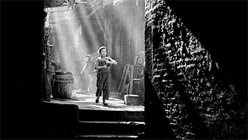For Fan Ho, whose exhibition The Living Theatre coincides with the publication of a limited edition art book of the same name, Hong Kong is a shadow-filled and smoky place, where children grasp what they can of their youth and everyone else toils in placid determination. Consisting of 150 photographs taken immediately after World War II, Ho shot the bulk of these photos when he was in his 20s — some were snapped when he was still in his teens. All reflect his then-youthful eye, which was not yet mature enough to dismiss even the most minor details of the spectacle before him. Lucky us.
Modernbook Gallery has done a fine job of bringing Ho’s Hong Kong, with its gorgeously bleak cityscape and densely packed harbor, to life. The multi-level gallery, as well as the loft above it, is crammed with Ho’s pictures, which themselves are filled with every nook and cranny of Hong Kong. Some have been reproduced in large, eye-catching formats that draw us in from across the room. Other images are tiny, swimming within frames that are deliberately grander than their contact-sheet size. Just about all are vintage prints from a half-century ago. Many were developed in Ho’s bathtub.
As a portrait of a place long gone, Ho’s work is an indispensible time capsule, but it is also very smart art. Ho has a terrific sense of composition, capturing life in the slums of Hong Kong with both affection and perception. Ho does not glorify his subjects — he does place the men, women, and street urchins that people his photographs on pedestals for suffering the burdens of their lower-than-proletariat stations in life. But Ho is a good reporter, and report he does on what he calls, in one image from 1957, the “unceasing toil” of life in post-war Hong Kong. His camera does not flinch, but the artist is not intent on shocking us into doing the same. We see what he saw, and all we can do is marvel at the terrible beauty of it all.
Several themes emerge. First and foremost, there is the work. Men swing picks in a stone quarry, others shovel aside their comrades’ debris. Men and women alike are pressed into service, pushing the poles of their sampans to make their way from point to point in the busy harbor, in search of what are doubtless meager rewards. Men and women also carry baskets, each suspended from the end of a bamboo pole. The contraption, known as a dam chi, which literally means “carry burden,” appears to ride effortlessly on their stooped shoulders, but we know that unpadded piece of bamboo, torqued by the weights swinging from its ends, must dig hard into the beaten bodies of their bearers. Smoke from fires, smoke from dust, smoke from sweaty humanity pressed tightly together fills the air.
Ho’s Hong Kong is also a place of patterns captured for their own sake. We see the repetition of open windows in a back alley, rectangles of white against the black and the gray. A stairway lit from somewhere above disintegrates before our eyes into an abstract composition of horizontal parallel lines bisected by a vertical shaft of light that is, in fact, the stairway’s center handrail. In other pictures, we are flat-out fooled, as in the photograph of a woman cleaning a set of Venetian blinds. More horizontal lines, we think, until we notice — and not at first — that she is attired in a vertically striped pantsuit. Gotcha, smiles the artist.


